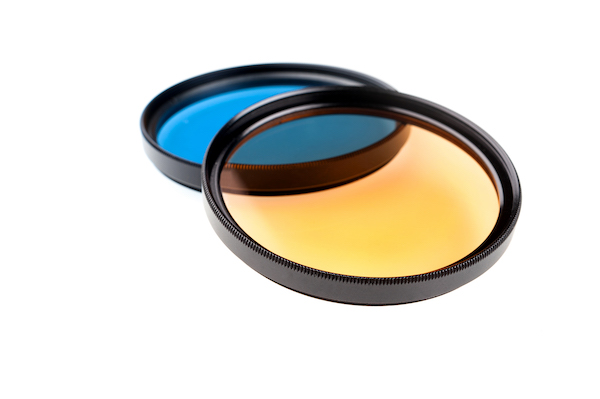Filters are devices that allow specific stuff to pass through them and reject or block the rest. In the context of optical communication, optical filters are used for pretty much the same thing. Optical filters promote the transmission of different wavelengths while absorbing those that are not required — they often pass long wavelengths, short wavelengths, or a selective band of wavelengths. These filters are commonly used in machine vision, spectroscopy, and microscopy.
How do optical filters function?
Depending on the ways of filtering, optical filters are categorized as absorptive optical filters and dichroic optical filters (also called thin-film filters or interference filters). Absorptive optical filters block the light using the absorption properties of the glass substrate used. These are not impacted by the angle the light is coming from — they retain their transmission and absorption capabilities, irrespective of the angle.
On the other hand, dichroic optical filters reflect uninvited wavelengths and transmit the desired ones. Their glass is covered with a thin dielectric coating, and they demonstrate sharp transitions between transmitted and reflected wavelengths. In addition, dichroic optical filters are angle-sensitive.
Popular types of optical filters
Monochromatic: As the name suggests, monochromatic optical filters are used when the transmission of only a single color is required. For this reason, these optical filters have a narrow wavelength.
Ultraviolet: UV optical filters are used for applications that require UV blocking, as they efficiently block UV radiation and only transmit visible light. These are commonly used in cameras, as the film is sensitive to ultraviolet light.
Infrared: Infrared filters are used for two primary purposes. The first is to block other wavelengths and allow infrared and the second is to block infrared only. Infrared-passing filters allow the passing of infrared while blocking all other wavelengths. The filters that cut off infrared are used to block infrared and transmit visible light.
Natural density: These optical filters reduce the intensity of wavelengths of light by filtering part of each wavelength. They allow photographers to capture clear pictures even in bright light. Natural density optical filters can be either absorptive or reflective.
Longpass: As the name implies, longpass optical filters transmit longer wavelengths, such as infrared and ultraviolet light. They are made of colored glass and efficiently block shorter wavelengths. Longpass optical filters are commonly used in fluorescence microscopy — a branch of life sciences concerned with monitoring cell physiology.
Shortpass: In contrast to longpass filters, shortpass optical filters transmit shorter wavelengths and reflect longer ones.
Bandpass: Many applications require specific bandwidth or center wavelengths, which longpass or shortpass filters cannot offer. This is when customized bandpass filters come to use. They are designed by equipping and stacking together both longpass and shortpass optical filters. These filters are a cost-effective way to transmit a specific wavelength band — the layers in the bandpass filters can be manipulated to produce the required range of light.
All about bandpass filters
Bandpass filters mean that they allow the ‘passing’ of a particular ‘band’ of wavelength. Since they are fully customizable, they are ideal for a broad range of practical applications, including microscopy, flow cytometry, clinical chemistry, imaging, and spectroscopy. Research and Development (R&D) and life sciences (biology, anatomy, biotechnology, ecology, and more) are the two most popular fields known to use bandpass filters.
Additionally, bandpass filters are available in various sizes, shapes, and thicknesses and manufactured using a range of different construction technologies. They block all unwanted wavelengths by either absorbing, reflecting, or doing both.
Bandpass optical filters are typically divided into two categories: narrowband filters and wideband filters. While narrowband optical filters pass less than 1% of the incident light, the wideband ones allow 10% or more of incident light to pass through them.
Design
As mentioned above, a customized bandpass filter is a composition of longpass and shortpass optical filters. It is designed by layering the essential materials on the surface of the substrate. Every bandpass optical filter consists of these components:
- A thin film Fabry–Pérot interferometer (FPI) or etalon, which is formed using vacuum deposition techniques
- Two reflecting stacks that separated by even-numbered spacer layers
Each of these structures is called a cavity, and bandpass filters can contain as many as eight cavities.
There are variations even in the designs of bandpass filters. The two main types of bandpass filter designs are all-dielectric and metal dielectric. The all-dielectric bandpass optical filter is made of two high-reflective mirrors, composed of alternating high refractive index and low refractive index materials. These mirrors are separated by a dielectric isolation layer. As per the requirements, the center wavelength and bandwidth of the bandpass optical filter can be modified by manipulating the thickness of either the isolation layer or the reflective layer.
The metal-dielectric bandpass optical filter, on the other hand, pretty much resembles an all-dielectric type bandpass optical filter in all ways but one. What differentiates the two types is that metal-dielectric bandpass optical filters contain a metal spacer layer. The metal-dielectric filter is lauded for its efficient blocking and high-passband transmission abilities.
Let Universe Kogaku’s lens application engineers supply you with the best lens solution
At Universe Optics, we manufacture a wide range of lens filters, including ultraviolet and infrared bandpass filters. All our products are produced with precision by a team of skilled designers and engineers. We ensure our lens solutions meet all your needs and are customized to your applications. To discuss your unique requirements with us, get in touch at 1-516-624-2444 or contact us online today.
